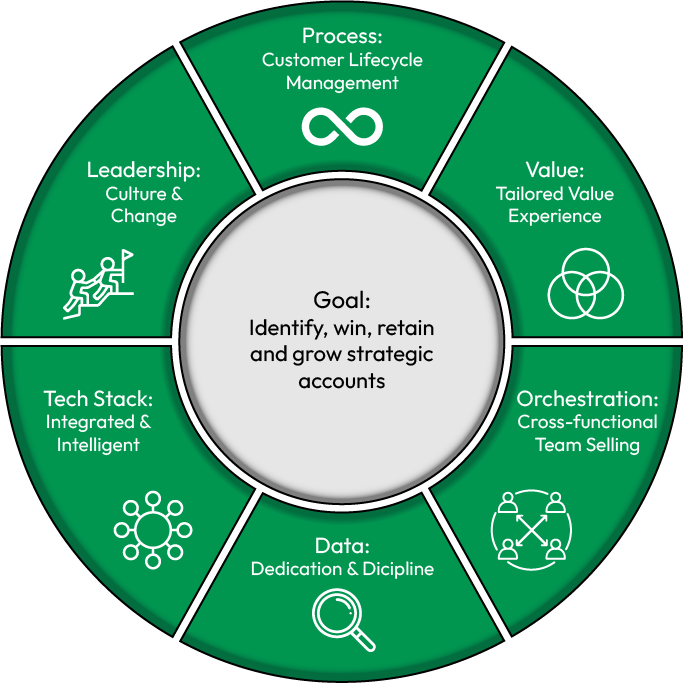A learning environment that’s anything but conventional
ARPEDIO was right in the middle of it all, surrounded by Strategic Account Management (SAM) professionals who shared our drive for success and eagerness to push boundaries and exchange game-changing ideas about the future of SAM.
Keynotes from thought leaders included Tom Derry, CEO of the Institute for Supply Management; Miguel Gonzalez, Chief Procurement Officer at DuPont; Dan Gardner, award-winning journalist and bestselling author; and Hitendra Wadhwa, professor at Columbia Business School, adding a spark that ignited engaging discussions and fresh perspectives.
At the conference, the learning environment is designed to be anything but conventional. It’s a dynamic and energetic think tank where genuine passion for idea-sharing takes center stage, creating a vibrant atmosphere that both invigorates and captivates. This year’s conference not only provided a platform for like-minded professionals within the SAM space to connect and collaborate but also ignited a spirit of innovation that will undoubtedly drive the future of SAM.
Navigating the technological evolution of SAM
At the conference, our CEO, Ulrik Monberg, had the privilege of sharing the stage with Chris Wells, Director of Strategic Accounts at bioMérieux, for an insightful session on “Navigating SAM evolution: Insights on technological transformation.”
They discussed their compelling journey through the SAM landscape, emphasizing not just the technological aspects but also how SAM evolves through a blend of strategic insight and technological innovation. While technology has played a significant role, it’s the broader strategic elements that have been truly transformative.
Through a mix of strategic insights and real-world examples, Ulrik and Chris provided a comprehensive overview of the evolution of SAM and the pivotal role of technology in driving growth and efficiency. Let’s dive in.
The Preferred
Account-Based Selling Platform
Our platform provides visual org charts, stakeholder relationship heat maps, up-to-date account plans, recommended next-best actions, accurate weighted pipelines, and white space analysis.
-
100% Native to Salesforce
-
Methodology Agnostic
-
Advanced enough to create a real impact
-
Simple enough to secure adoption
Assess your maturity level for account-based growth
During the session, Ulrik introduced the Account-Based Selling (ABS) Maturity Model, a framework where the overall goal is to reach a high maturity level to be able to identify, win, retain, and grow high-value accounts.
This model encapsulates six critical elements, serving as a benchmark for assessing your company’s maturity on ABS and identifying areas where you need to enhance your effort with the right technology. These components also form the backbone of a successful SAM program. The six enablers are:
- Leadership: A foundational aspect of ABS technology adoption is the leadership and culture within the organization. Effective leadership must champion the use of technology and foster a culture that supports technological integration to drive key elements of ABS.
- Processes: Establishing well-defined processes is crucial. This includes for example SAM certification to ensure that the right processes are embedded within the company. Technology plays a pivotal role in enabling and streamlining these processes.
- Value: Understanding and clearly communicating what the company is selling is vital. Technology facilitates a coherent communication strategy, ensuring that the value proposition is consistently conveyed to high-value accounts.
- Orchestration: Ensuring that the language and processes within a company are standardized. This standardization allows for seamless movement between accounts while maintaining consistent processes. Evaluating stakeholders, setting objectives, and targeting revenue should be unified across the organization. Technology is essential to support and sustain this orchestration.
- Data: The success of AI initiatives hinges on the quality of data. It is essential to have clean data, a thorough understanding of the data you possess, and clarity on the data you need. This groundwork is crucial for any subsequent AI-driven efforts.
- Tech stack: Achieving successful ABS requires integrating technology that supports and enhances leadership, culture, processes, value, and orchestration. Technology ensures that all these elements work in harmony, driving the success of ABS initiatives. The maturity of an organization’s tech stack significantly impacts its ability to implement Key Account Management (KAM) technologies. Companies need to assess whether their existing infrastructure can support these technologies or if additional investments are required.
To assist organizations in their journey towards implementing a successful SAM program, ARPEDIO has developed the ABS Maturity Framework. The framework helps companies evaluate their maturity in driving account-based growth, offering a structured approach to enhancing their tech stack and data practices.
By assessing the company or SAM practice in the maturity model, organizations and/or teams can systematically improve their account-based technology efforts. This approach ensures that foundational elements such as leadership, processes, value, orchestration, tech and data quality are in place. This enables companies to leverage technology effectively in their ABS efforts.
Successful AI implementation begins with data
Let’s dwell at AI for a moment. Undoubtedly, AI has been an extremely hot topic in recent years. However, the journey to successful AI integration in ABS actually starts with establishing a robust foundation of clean, well-understood data. Before being able to effectively leverage AI, it is crucial to conduct thorough data analysis to define benchmarks and understand what successful accounts look like compared to underperforming ones. This analysis provides the necessary insights to train AI models effectively.
Ulrik highlighted the potential of Generative AI (Gen AI) in automating and enhancing various functions, such as content creation and predictive analytics. Again, the effectiveness of these AI tools depends on the foundational data work. Investing time in the data journey is essential, encompassing not only collecting and cleaning data but also analyzing it to extract meaningful insights. These insights then inform the AI models, enabling them to distinguish between high-performing and low-performing key accounts.
Evolving data practices at bioMérieux
Building upon the discussion on the importance of data in AI implementation, Chris provided insights into the evolution of data practices, showcasing the remarkable advancements made by organizations like bioMérieux as they’ve journeyed through evolving data practices. He emphasized that better data quality has led to increased use of AI. The significant improvement in data quality compared to previous years can be attributed to ongoing enhancements in the tech stack.
Reflecting on the journey, Chris described the initial challenges faced, particularly in setting up their data systems. The painstaking task of obtaining login details and meticulously organizing the data hierarchy underscores the importance of starting with good data and continually improving data practices. Such initiatives are essential for all companies aspiring to utilize the full potential of AI and data-driven strategies.
BioMérieux’s story reinforces the core message – that SAM and technological transformation are intrinsically linked, while highlighting the pivotal role of high-quality data in driving AI utilization and the importance of ongoing efforts to enhance data practices.
Adoption and common pitfalls in technology implementation
It’s a common misconception that simply acquiring software will solve all organizational problems. The successful implementation of technology requires a committed and integrated approach across the entire organization.
Regardless of whether the data is managed in Word, Excel, or any sophisticated software, the real challenge lies in the commitment to use this data effectively within regular processes. It’s essential that the data generated is actively utilized across the organization to drive actionable insights and decisions. Without this commitment, even the most advanced technology can fall short of delivering its potential benefits. The software alone cannot address underlying process issues or drive cultural change; it must be integrated with a clear strategy and strong organizational support.
Another common mistake is using multiple disjointed systems. This fragmentation can lead to inefficiencies and undermine the enforcement of data-driven practices. To truly benefit from these platforms, organizations need to centralize their data management and ensure consistent use of the chosen technology.
For technology to be effective, there must be a concerted effort to enforce its use across all relevant processes. This means integrating the technology seamlessly into daily operations and ensuring that all team members are on board and properly trained. It’s not enough to have the tools; the organization must also cultivate a culture that values and utilizes data consistently and effectively.
Conclusion
At the SAMA Annual Conference 2024, Ulrik Monberg and Chris Wells provided valuable insights into the evolution of SAM through their session on “Navigating SAM Evolution: Insights on Technological Transformation.” They highlighted the importance of integrating strategic insight with technological innovation, drawing from real-world examples to illustrate their points. Here are the three main takeaways from their session, contextualized within the ABS Maturity Model:
- Strong leadership and processes: Leadership and culture are foundational to ABS technology adoption. Effective leadership must champion technological integration, and well-defined processes are essential for success. These elements ensure that SAM initiatives are built on solid ground, facilitating the integration and effective use of technology.
- Data quality for AI integration: Clean, well-organized data is crucial for effective AI integration in SAM. High-quality data forms the bedrock for training AI models and deriving meaningful insights, enabling better decision-making and strategic growth.
- Comprehensive technology adoption: Technology adoption requires a holistic approach. Organizations must commit to integrating and using technology across all relevant processes, ensuring data is centralized and utilized effectively. Avoiding fragmented systems and fostering a culture that values consistent data use maximizes the benefits of technology investments.
These takeaways underscore that mastering SAM and integrating technology is a multifaceted, ongoing process. The ABS Maturity Model provides a structured framework for organizations to assess and enhance their maturity in account-based growth, ensuring that foundational elements such as leadership, processes, and data quality are in place. This approach enables companies to leverage technology effectively and achieve greater efficiency and strategic growth in their SAM efforts.
About ARPEDIO
As global technology partners to the Strategic Account Management Association (SAMA), ARPEDIO plays a pivotal role in advancing Strategic Account Management (SAM) initiatives. ARPEDIO’s platform for Account-Based Selling (ABS) was specifically developed to empower SAM mechanisms and support SAM processes effectively, addressing a critical gap in the market. Recognizing that existing tools often lacked the necessary functionalities, the platform was designed to work seamlessly with Salesforce, ensuring all data remains secure and centralized. The platform aims to be user-friendly to encourage adoption while being robust enough to generate valuable insights.
ARPEDIO’s suite of components supports transformational journeys within organizations. These tools have been rigorously tested in collaboration with members of the SAMA community to ensure they meet the real-world needs of Strategic Account Managers.
A significant part of ARPEDIO’s vision is to shift the perception of SAM from merely a role within an organization to a strategic asset. This transformation involves evolving from initial program adoption to fully integrating SAM into the strategic fabric of the organization. ARPEDIO’s tools and processes are designed to facilitate this transition, helping organizations develop sound and effective SAM programs.














